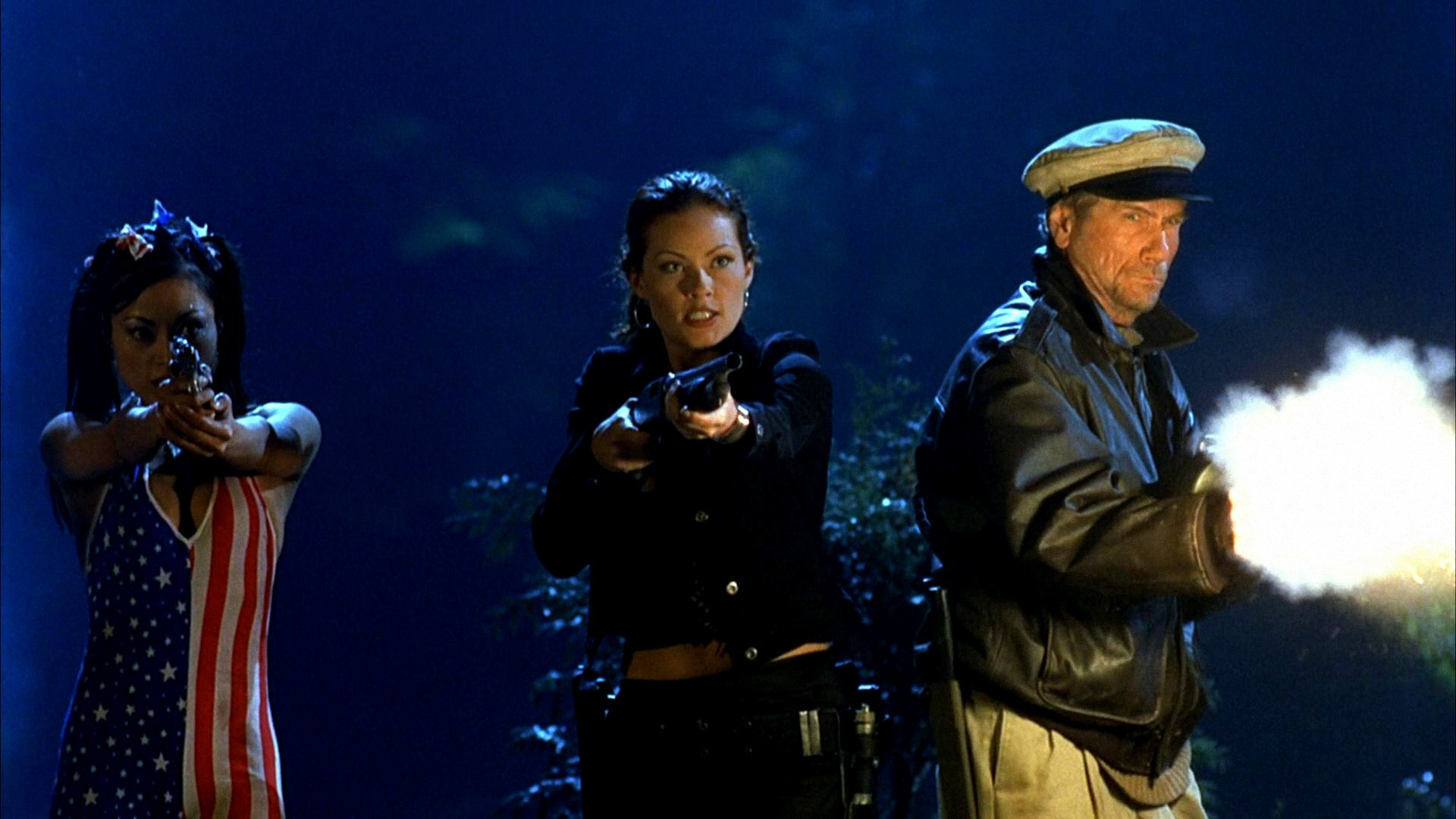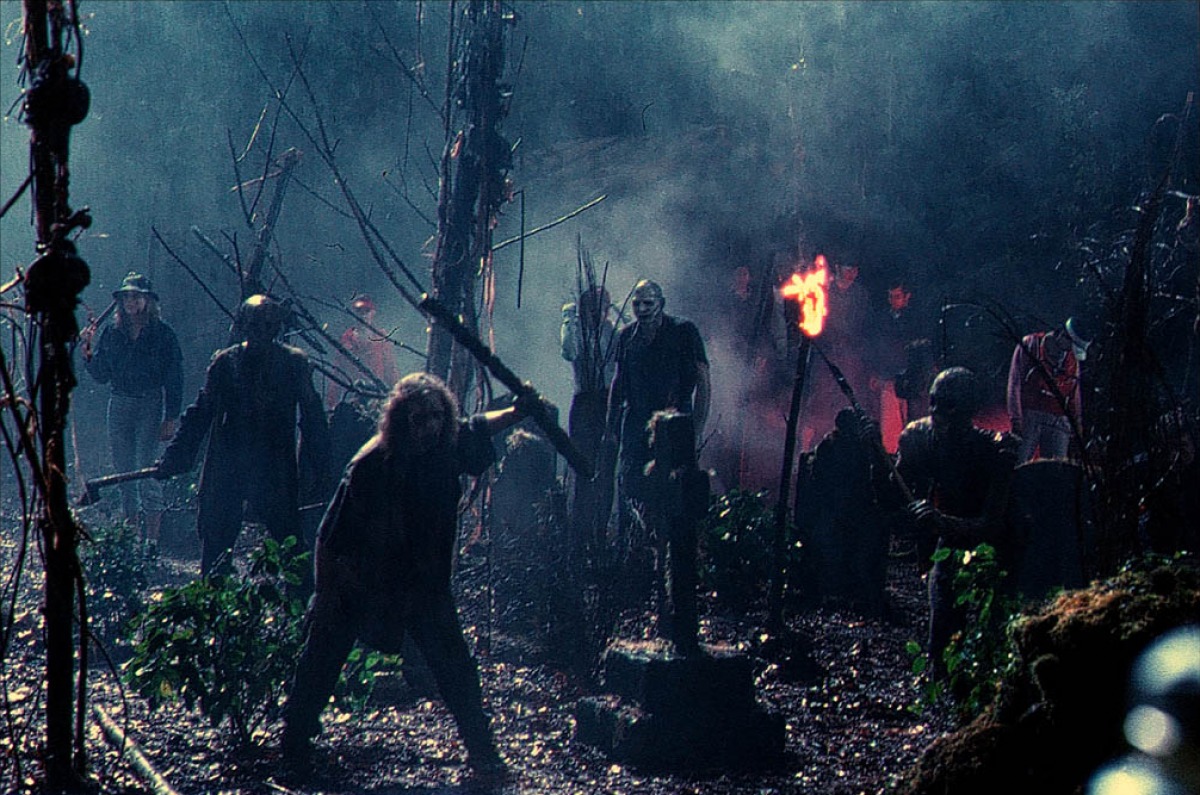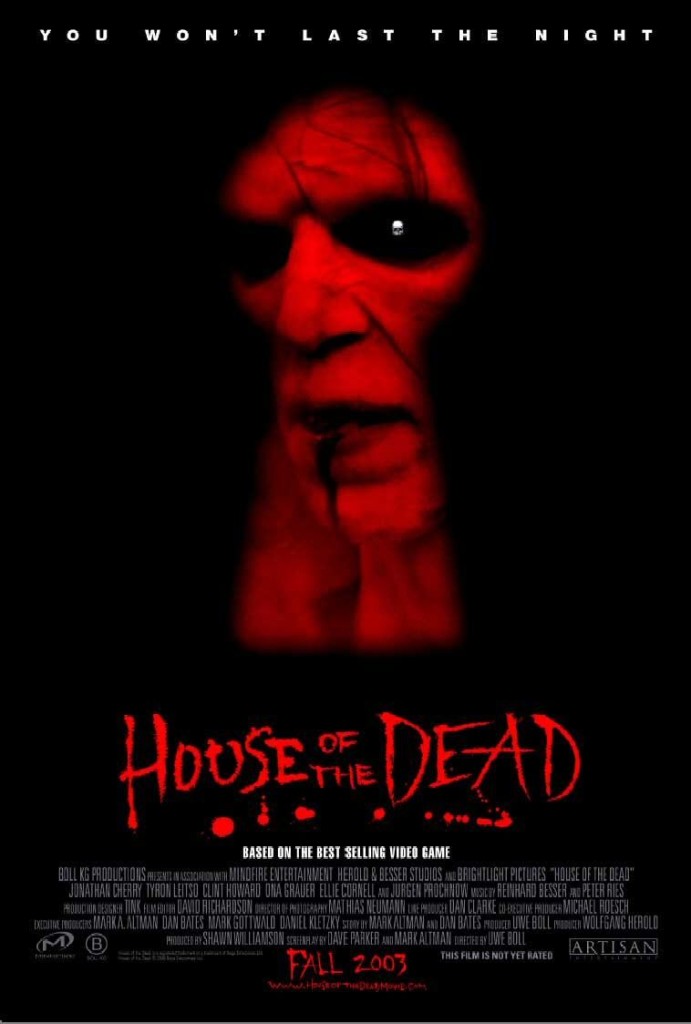Germany/Canada/USA. 2003.
Crew
Director – Uwe Boll, Screenplay – Mark Altman & David Parker, Story – Mark Altman & Dan Bates, Based on the Videogame from Sega Corporation & Wow Entertainment Inc., Producers – Uwe Boll, Wolfgang Herold & Shawn Williamson, Photography – Mathias Neumann, Music – Reinhard Besser & Peter Ries, Visual Effects Supervisor – Max Wanko, Digital Effects – Toybox, Special Effects Supervisor – John Sleep, Makeup Effects/Prosthetics – WCT Productions (Supervisor – Bill Terezakis), Production Design – Tink. Production Company – Boll KG/Mindfire Entertainment/Birthlight Pictures/Herold & Besser Studios/Dritte Boll Kino Beteiligungs GmbH & Co. KG.
Cast
Jonathan Cherry (Rudy), Ona Grauer (Alicia), Jurgen Prochnow (Captain Victor Kirk), Ellie Cornell (Jordan Casper), Tyron Leitso (Simon Cruise), Enuka Okuma (Karma), Will Sanderson (Greg), Kira Clavell (Liberty), Sonya Salomaa (Cynthia), Clint Howard (Salish), David Palffy (Castillo), Michael Eklund (Hugh), Erica Parker (Johanna), Steve Byers (Matt)
Plot
A group of friends from Seattle charter the fishing boat of smuggler Victor Kirk to travel out to an island where a big rave party is being held. Upon arriving, they find that the other partygoers have all been massacred. They are then attacked by zombies. Armed with Kirk’s illegal cache of weapons, they fight the zombies off in a bloodthirsty battle. Taking siege in a house, they discover the secret of how the zombies were created by a 17th Century Spanish black sorcerer.
In the mid-00s, German born director Uwe Boll attained an astoundingly bad reputation. If any of this is to be believed, Boll rivals Edward D. Wood Jr for total directorial incompetence. Boll made several films in his native Germany and then moved to English language with the American-made serial killer thriller Sanctimony (2000), followed by the psycho-thriller Blackwoods (2002) and the high school shootings drama Heart of America: Home Room (2002). None of these attained much notice until Boll made House of the Dead here, which attracted some incredibly bad reviews. Boll continued on with Alone in the Dark (2005) and BloodRayne (2005) by which time Boll-bashing became a phenomenon. House of the Dead, Alone in the Dark and BloodRayne are all based on videogames and have a reputation as extraordinarily bad works – indeed, as of this writing, all three films sit on the Internet Movie Database’s Bottom 100 films list. Boll eventually became so frustrated with the scathing reviews his films were receiving that in 2006 he challenged his critics to a boxing match.
Uwe Boll has created his own production company Boll Kino Beteiligungs GmbH & Co. KG. He usually co-produces with various German and Canadian production companies, obtaining financing from independent sources, and shoots in Canada. He subsequently made several other computer-game adapted films and puts out at least 2-3 films each year (see below for Uwe Boll’s other genre films). House of the Dead also interestingly comes co-written by uber-fan Mark Altman, director-writer of the hilarious fan film Free Enterprise (1998) and editor/writer on numerous fannish prozines.
House of the Dead is based on the videogame of the same name, which was first released in 1996 and has led to three sequels and four spinoff games. House of the Dead was another of the First Person Shooter variants on Doom wherein players must fend off ravening zombies. The nominal plot involved two government agents who must venture into a mad scientist’s mansion laboratory (the titular house), despatching the zombies he has created and save the hero’s girlfriend from an ill-intended fate. Boll’s film purports to be a prequel to the game – the government agents we see arriving at the very end are supposed to be the two heroes of the game.

House of the Dead was one of a host of films that came out around the same time influenced by the zombie films of George Romero – Night of the Living Dead (1968), Dawn of the Dead (1978) and Day of the Dead (1985). Romero’s films have developed a renewed popularity in recent years in terms of homages, sequels and remakes, which have included the likes of 28 Days Later (2002), the remakes of Dawn of the Dead (2004) and Day of the Dead (2008), Shaun of the Dead (2004), Day of the Dead 2: Contagium (2005) and Night of the Dead “Leben Tod” (2006), among a vast army of others. Romero’s trilogy is even amusingly referenced here at one point with the situation being compared to a Romero film. “Who’s Romero?” asks one character. “The Holy Trilogy – Night, Dawn and Day of the Dead. They say he’s going to make Twilight of the Dead someday but I kinda doubt it, you know.” (A point that Romero promptly proved wrong by making Land of the Dead (2005) a couple of years after House of the Dead came out).
On all levels, House of the Dead is a generic zombie film. The script feels as though it has been indifferently slung together with only a minimal effort made to explain proceedings. Most of the zombie killings have a certain basic technical competence upon Uwe Boll’s part but an entirely mechanical feel to them. The opening zombie attack with the character of Cynthia (Sonya Salomaa) bursting out covered in blood, roaring and grabbing people before being blown away by the deputy with a high-power rifle and then a handgun must count as one of the least convincing zombie attacks ever portrayed on screen.
Things get very silly when Uwe Boll starts doing Bullet Time sequences, circling in ultra-slowed motion around his combatants as they shoot at zombies. Indeed, while most of George Romero’s zombie films seem driven by outrageous gore set-pieces, Uwe Boll’s film seems driven by action movie poses and relentless desire to copy the Bullet Time effects from The Matrix (1999). The video cover advertises House of the Dead as being the rather absurd notion of “Night of the Living Dead meets xXx (2002),” which, if nothing else, is an accurate description of the film. Boll for no clear reason also throws in random flashes of graphics from the videogame throughout, an effect that is only daft. Everything is run over with a pounding techno score. Boll also casts Clint Howard, where Howard manages to give an excruciatingly bad performance as a bugged-out sailor.

On the plus side, while I was prepared to look at House of the Dead as a modern equivalent of Plan 9 from Outer Space (1959), much and all as I tried I couldn’t hate it. In the wider perspective, House of the Dead only comes out around the level of a routine B horror release. Once one gets past the silly Bullet Time effects and inserts from the computer game, Uwe Boll manages to generate a moderate kinetic intensity during the venture through the house. Certainly, Boll is not unstinting when it comes to gore, something that many of the modern Romero copies have been. A notable comparison might be between House of the Dead and another Romero-copied, killer zombie videogame adaptation Resident Evil (2002). If nothing else, Uwe Boll makes House of the Dead a far more authentically Romero-esque gore-drenched zombie film than Resident Evil ever was.
House of the Dead 2 (2005) was a sequel made without Uwe Boll and is a much better film. This is largely unconnected to the first House of the Dead (or the videogame), other than featuring zombies, and uses a university campus as setting.
Uwe Boll’s other genre films are:- the serial killer films Amoklauf/Rampage (1994) and Sanctimony (2000); the backwoods horror Blackwoods (2002); the high school shooting rampage film Heart of America: Home Room (2002); the monster movie/videogame adaptation Alone in the Dark (2005); the vampire hunting videogame adaptation BloodRayne (2005) and its sequels Bloodrayne: Deliverance (2007) and Bloodrayne: The Third Reich (2011); the fantasy adventure In the Name of the King: A Dungeon Siege Tale (2007) and its sequels In the Name of the King: Two Worlds (2011) and In the Name of the King 3 (2014); the videogame adaptation Postal (2007), a surreal bad taste satire about a shooting rampage; Seed (2007) about an executed killer returned from the grave; the videogame adaptation Far Cry (2008); Rampage (2009) about a man on a shooting spree and its sequels Rampage: Capital Punishment (2014) and Rampage: President Down (2016); Stoic (2009) about sadism and brutality in a prison; The Final Storm (2010) about an apocalyptic storm and the arrival of a mysterious stranger; the gonzo bad taste comedy Blubberella (2011) about an overweight vampire heroine; Assault on Wall Street/Bailout: The Age of Greed (2013) about a man on a shooting spree against bankers; and a segment of the horror anthology The Profane Exhibit (2013). Boll has also produced the ghost story They Wait (2007), Alone in the Dark II (2008), Zombie Massacre (2012), Legend of the Red Reaper (2013), Prisoners of the Sun (2013), Morning Star (2014), Viy (2014), Anger of the Dead (2015), Zombie Massacre 2: Reich of the Dead (2015) and Jack Goes Home (2016). Fuck You All: The Uwe Boll Story (2019) is a surprisingly insightful documentary about Boll and his career.
Trailer here


